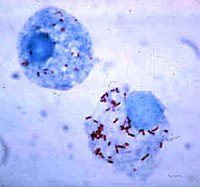
Photo from wikipedia
A previously unrecognized Rickettsia species was isolated in 1976 from a pool of Ixodes pacificus ticks collected in 1967 from Tillamook County, Oregon, USA. The isolate produced low fever and… Click to show full abstract
A previously unrecognized Rickettsia species was isolated in 1976 from a pool of Ixodes pacificus ticks collected in 1967 from Tillamook County, Oregon, USA. The isolate produced low fever and mild scrotal oedema following intraperitoneal injection into male guinea pigs (Cavia porcellus). Subsequent serotyping characterized this isolate as distinct from recognized typhus and spotted fever group Rickettsia species; nonetheless, the isolate remained unevaluated by molecular techniques and was not identified to species level for the subsequent 30 years. Ixodes pacificus is the most frequently identified human-biting tick in the western United States, and as such, formal identification and characterization of this potentially pathogenic Rickettsia species is warranted. Whole-genome sequencing of the Tillamook isolate revealed a genome 1.43 Mbp in size with 32.4 mol% G+C content. Maximum-likelihood phylogeny of core proteins places it in the transitional group of Rickettsia basal to both Rickettsia felis and Rickettsia asembonensis. It is distinct from existing named species, with maximum average nucleotide identity of 95.1% to R. asembonensis and maximum digital DNA-DNA hybridization score similarity to R. felis at 80.1%. The closest similarity at the 16S rRNA gene (97.9%) and sca4 (97.5%/97.6% respectively) is to Candidatus 'Rickettsia senegalensis' and Rickettsia sp. cf9, both isolated from cat fleas (Ctenocephalides felis). We characterized growth at various temperatures and in multiple cell lines. The Tillamook isolate grows aerobically in Vero E6, RF/6A and DH82 cells, and growth is rapid at 28 °C and 32 °C. Using accepted genomic criteria, we propose the name Rickettsia tillamookensis sp. nov., with the type strain Tillamook 23. Strain Tillamook 23 is available from the Centers for Disease Control and Prevention Rickettsial Isolate Reference Collection (WDCM 1093), Atlanta, GA, USA (CRIRC accession number RTI001T) and the Collection de Souches de l'Unité des Rickettsies (WDCM 875), Marseille, France (CSUR accession number R5043). Using accepted genomic criteria, we propose the name Rickettsia tillamookensis sp. nov., with the type strain Tillamook 23 (=CRIRC RTI001=R5043).
Journal Title: International journal of systematic and evolutionary microbiology
Year Published: 2021
Link to full text (if available)
Share on Social Media: Sign Up to like & get
recommendations!